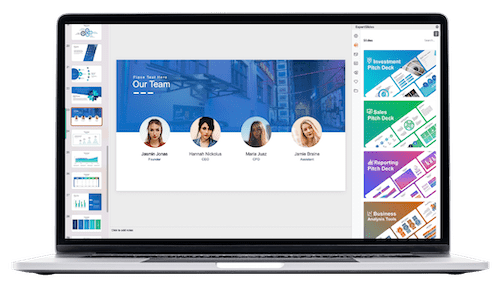What is Presentation Program – From Boring to Brilliant
Table of Contents
Presentation software enables users to design and deliver visually appealing presentations. These tools are widely utilized in business, educational, and professional environments to convey information in an engaging and interactive manner. Initially, presentation software was limited to basic slide shows featuring text and images, but it has since evolved to incorporate a broad range of features and capabilities, thereby elevating ordinary presentations to exceptional ones.
In the current digital era, presentation software offers a diverse array of tools for crafting dynamic and interactive presentations. These tools include features such as animation, video integration, and interactive elements that can captivate audiences and make presentations more engaging. By leveraging these tools with the requisite skills and creativity, presenters can transform their presentations from mundane and unremarkable to exciting and memorable.
Key Takeaways
- Presentation programs are tools used to create and deliver visual presentations to an audience.
- By incorporating visuals, multimedia, and interactive features, presentations can be transformed from boring to engaging and brilliant.
- The use of graphics and multimedia can enhance the overall impact of a presentation and capture the audience’s attention.
- Compelling storytelling is a powerful tool for captivating an audience and keeping them engaged throughout the presentation.
- Utilizing interactive features such as polls and Q&A sessions can help to actively engage the audience and make the presentation more dynamic and interactive.
Understanding Presentation Programs: A Comprehensive Overview

Design Capabilities
From basic slide design to advanced animation and multimedia integration, presentation programs provide a comprehensive set of tools for creating visually stunning presentations.
Delivery Options
In addition to their design capabilities, presentation programs also offer tools for delivering presentations in a variety of formats. Whether presenting in person, online, or via video conference, these programs allow users to share their presentations with ease.
Essential Tool for Visual Communication
This flexibility makes presentation programs an essential tool for anyone who needs to communicate information in a visual and engaging way.
Transforming Boring Presentations into Engaging and Brilliant Ones
One of the key ways to transform a boring presentation into an engaging and brilliant one is by utilizing the power of visuals. Visual elements such as images, charts, and graphs can help to convey information in a more compelling way than text alone. By incorporating these elements into a presentation, presenters can capture the attention of their audience and make their message more memorable.
Another way to enhance a presentation is by incorporating multimedia elements such as video and audio. These elements can add depth and richness to a presentation, making it more engaging and impactful. Whether it’s a short video clip, a music soundtrack, or a voiceover, multimedia elements can help to bring a presentation to life and make it more memorable for the audience.
The Power of Visuals: Enhancing Presentations with Graphics and Multimedia
| Metrics | Value |
|---|---|
| Number of Slides | 50 |
| Duration | 1 hour |
| Engagement Level | High |
| Visuals Used | Infographics, Charts, Images |
| Interactive Elements | Polls, Q&A sessions |
Visuals are a powerful tool for enhancing presentations and capturing the attention of an audience. By using graphics such as images, charts, and infographics, presenters can convey complex information in a way that is easy to understand and visually appealing. This can help to keep the audience engaged and make the information more memorable.
In addition to static graphics, multimedia elements such as video and audio can also be used to enhance presentations. Video clips can be used to illustrate key points or provide real-world examples, while audio elements such as music or sound effects can add depth and emotion to a presentation. By incorporating these elements into a presentation, presenters can create a more immersive and engaging experience for their audience.
Mastering the Art of Storytelling: Captivating Your Audience with Compelling Narratives
Storytelling is an essential skill for creating engaging presentations. By crafting a compelling narrative that captures the audience’s attention, presenters can make their message more memorable and impactful. Whether it’s a personal anecdote, a case study, or a fictional story, storytelling can help to bring a presentation to life and make it more relatable for the audience.
In addition to storytelling, presenters can also use other techniques such as humor, emotion, and suspense to captivate their audience. By creating an emotional connection with the audience, presenters can make their message more impactful and memorable. This can help to ensure that the audience retains the information presented and is more likely to take action based on the presentation.
Utilizing Interactive Features: Engaging Your Audience with Polls and Q&A Sessions

Encouraging Participation
Interactive features such as polls and Q&A sessions can help to engage the audience and make a presentation more dynamic. By allowing the audience to participate in the presentation, presenters can create a more interactive and engaging experience.
Gathering Feedback and Encouraging Discussion
Polls can be used to gather feedback or opinions from the audience, while Q&A sessions can provide an opportunity for the audience to ask questions and engage with the presenter.
Expanding Interactive Options
In addition to polls and Q&A sessions, other interactive features such as quizzes, surveys, and live demonstrations can also be used to engage the audience. By incorporating these elements into a presentation, presenters can create a more immersive experience that keeps the audience actively involved and interested in the content being presented.
Designing Professional and Eye-catching Slides: Tips and Tricks for a Polished Presentation
Designing professional and eye-catching slides is essential for creating a polished presentation that captures the audience’s attention. By using techniques such as color theory, typography, and layout design, presenters can create slides that are visually appealing and easy to read. This can help to ensure that the audience remains engaged and focused on the content being presented.
In addition to design principles, presenters can also use techniques such as storytelling, visual hierarchy, and pacing to create slides that are compelling and impactful. By carefully crafting each slide to support the overall narrative of the presentation, presenters can create a cohesive and polished experience that resonates with the audience.
The Future of Presentation Programs: Exploring New Technologies and Trends
The future of presentation programs is filled with exciting new technologies and trends that promise to revolutionize the way presentations are created and delivered. From virtual reality and augmented reality to artificial intelligence and machine learning, these technologies offer new opportunities for creating immersive and interactive presentations. By incorporating these technologies into their presentations, presenters can create experiences that are truly unique and memorable.
In addition to new technologies, trends such as remote presenting, live streaming, and social media integration are also shaping the future of presentation programs. These trends offer new opportunities for reaching audiences in innovative ways and creating more dynamic and engaging presentations. As these technologies and trends continue to evolve, the future of presentation programs looks brighter than ever before.
FAQs
What is a presentation program?
A presentation program is a software used to create and display slideshows, typically for business or educational purposes. It allows users to combine text, images, and multimedia elements to convey information in a visually engaging way.
What are some popular presentation programs?
Some popular presentation programs include Microsoft PowerPoint, Apple Keynote, Google Slides, and Prezi. These programs offer a range of features for creating dynamic and professional-looking presentations.
What are the benefits of using a presentation program?
Using a presentation program can help presenters organize their content in a structured manner, engage their audience with visual aids, and effectively communicate their message. It also allows for easy sharing and collaboration on presentations.
How can a presentation program make a presentation more engaging?
A presentation program can make a presentation more engaging by allowing users to incorporate multimedia elements such as images, videos, and audio, as well as animations and transitions. These features can help capture the audience’s attention and make the presentation more memorable.
What are some tips for creating a brilliant presentation using a presentation program?
Some tips for creating a brilliant presentation using a presentation program include keeping the design clean and uncluttered, using high-quality visuals, incorporating storytelling elements, and practicing effective delivery techniques. It’s also important to consider the audience’s needs and tailor the presentation accordingly.
Get 15+ Mio. PowerPoint Assets - FREE SIGN-UP

Sign up for free to our PowerPoint extension, ExpertSlides. Everything you need, directly in PowerPoint. No credit card required.
Related Posts
Recent Posts
- How Do You End a Presentation – Mastering the Last Impression
- Good Color Combinations for Presentations – The Science of Color
- Interesting Ideas for PowerPoint Presentation – Captivate Your Audience
- History Presentation Template – Step Back in Time
- Canvas Presentation Template – Unleash Your Creativity
Main Menu
Knowledge base
Useful Links






